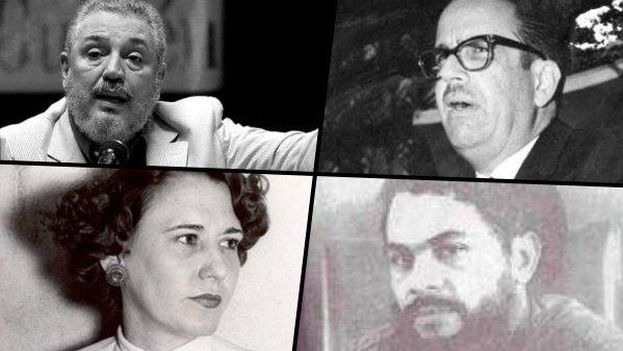
![]() 14ymedio, Marcelo Hernandez, Havana, 2 February 2018 — The suicide of Fidel Castro Díaz-Balart on Thursday is added to a long list of figures linked to power in Cuba who have chosen to end their lives in the last six decades. The history of the Cuban Revolution cannot be told without including its deserters, its exiles and, also, its suicides.
14ymedio, Marcelo Hernandez, Havana, 2 February 2018 — The suicide of Fidel Castro Díaz-Balart on Thursday is added to a long list of figures linked to power in Cuba who have chosen to end their lives in the last six decades. The history of the Cuban Revolution cannot be told without including its deserters, its exiles and, also, its suicides.
From 1959, the very first year, the casualties began. Commander Felix Lugerio Pena, who presided over the court during a prominent trial against 43 aviators of Fulgencio Batista’s National Army who had participated in actions against the rebels in the Sierra Maestra, took his own life that year.
The pilots were acquitted but the decision was reversed by orders of Fidel Castro and they ended up serving sentences of up to 30 years in prison. Shortly afterwards Pena died of a gunshot wound that officialdom hurried to explain as a suicide.
In this list there have also been frustrated suicides, such as that of the lawyer Augusto Martínez Sánchez, who was one of the rebels who reached the rank of commander in the Sierra Maestra. In 1959 he was appointed Military Prosecutor and was responsible for numerous executions, and later became Minister of Defense of the first revolutionary cabinet.
Martinez was the chief judge in the case against the participants in the Bay of Pigs invasion in 1961, and later he was Minister of Labor. In 1964 he shot himself in the chest but survived. After that he was removed from public life and died, ostracized, in 2013.
In 1972 Alberto Mora, son of the leader of the Authentic party, Menelao Mora, who organized the assault on the Presidential Palace in 1957, also committed suicide after having been a commander of the Revolution and director of the Foreign Trade Bank. The official press was silent.
Haydée Santamaría, one of the best known figures of the clandestine struggle and founder of the Casa de las Américas, committed suicide in July 1980 on the eve of July 26th (although some say it was on the day itself), the date of the assault on the Moncada Barracks in 1953 in which her brother Abel was killed and she was taken prisoner by the forces of Fulgencio Batista.
In 1953 Santamaría spent almost two months in a dungeon and later described those moments as “so much suffering” that she came to feel “desensitized.” Her boyfriend, Boris Luis Santa Coloma, who had not yet turned 25, also died in the Moncada assault.
At her death, Santamaría was not remembered with the honors corresponding to her historical importance. For decades Castroism has avoided giving official tributes to the figures who commit suicide. Her farewell letter explaining the reasons for her act has never been published.
“There is no room for suicides in the pantheon of the homeland,” a government leader, also associated with the cultural world, wryly commented to a group of friends at the time. The newspaper Granma, the official press of the Communist Party, reported the news only briefly.
Commander Juan Almeida commented at that moment, “In principle, we revolutionaries do not accept the decision of suicide, the life of the revolutionaries belongs to the cause of the Revolution and to the people.” Although he added that one could not “coldly judge comrade Haydée,” he said that everyone who knew her, including himself, understood that the wounds from the Moncada attack “never completely healed in her.”
In 2008, almost three decades after that event, Santamaría’s two children with Armando Hart, Celia Hart Santamaría, 45, and Abel Hart Santamaría, 48, died in a traffic crash that had all the traces of having been a suicide pact between siblings. For no apparent reason, the vehicle crashed into a tree.
The sister of Vilma Espin, one of the three most prominent female faces of the Cuban Revolution, also left this world through suicide. Nilsa Espín, sister-in-law of the current president, Raúl Castro, made a suicide pact with her husband, Rafael Rivero, in 1965. Her husband carried out the pact in a military camp in Pinar del Río, while she killed herself in Raúl Castro’s office.
In June 1983, after an intense discussion with Fidel Castro, according to witnesses, Osvaldo Dorticos, president of the Republic of Cuba from 1959 to 1976, shot himself.
Dorticós took his own life in the middle of an operation known as Toga Sucia [Dirty Robes], which the government launched to punish corrupt judges, but which many saw as a purge to leave the judiciary with only those most faithful to Castro. The official press insisted that the reason for Dorticós’ suicide had been a painful disease of the spine and depression due to the death of his wife, María Caridad Molina.
This Thursday, on the other hand, with the death of Fidel Castro Díaz-Balart – Fidel Castro’s oldest son born before the Revolution to his first wife Mirta Díaz-Balart – the official press has broken with a long tradition of covering up suicides. Were there so many witnesses that they could not hide the truth?
_________________________________
The 14ymedio team is committed to serious journalism that reflects the reality of deep Cuba. Thank you for joining us on this long road. We invite you to continue supporting us, but this time by becoming a member of 14ymedio. Together we can continue to transform journalism in Cuba.
